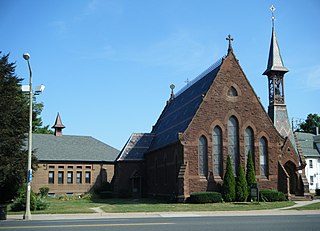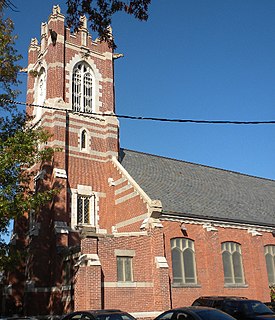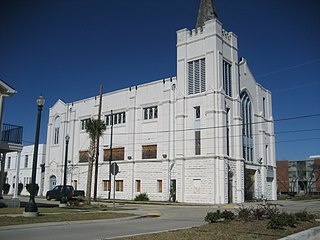
The Windsor Avenue Congregational Church is historic church at 2030 Main Street in Hartford, Connecticut. The brick Romanesque Revival-style church building, completed in 1872, now houses the Faith Congregational Church, whose lineage includes the city's oldest African-American congregation, established in 1819. The church is a stop on the Connecticut Freedom Trail and was listed on the United States National Register of Historic Places in 1993.

The Bethel Church is a Baptist megachurch in Jacksonville, Florida, in the United States. Founded in 1838, it is the city's oldest Baptist congregation. The attendance is 12,000 members. The senior pastor is Bishop Rudolph W. McKissick, Jr.

St. John African Methodist Episcopal Church was the first church for African Americans in Nebraska, organized in North Omaha in 1867. It is located at 2402 North 22nd Street in the Near North Side neighborhood. The building is listed on the National Register of Historic Places. The building was constructed in the center of Omaha's North Side in the Prairie School architecture style. Prairie School architecture is rare, and this architectural gem in urban Nebraska is particularly unusual for being designed and built in the 1920s, after the Prairie Style's rapid loss of popularity beginning after 1914.

Brown Chapel A.M.E. Church is a church at 410 Martin Luther King Jr. Boulevard in Selma, Alabama, United States. This church was a starting point for the Selma to Montgomery marches in 1965 and, as the meeting place and offices of the Southern Christian Leadership Conference (SCLC) during the Selma Movement, played a major role in the events that led to the adoption of the Voting Rights Act of 1965. The nation's reaction to Selma's "Bloody Sunday" march is widely credited with making the passage of the Voting Rights Act politically viable in the United States Congress.
Edward Tuckerman Potter was an American architect best known for designing the 1871 Mark Twain House in Hartford, Connecticut. With his half-brother William Appleton Potter, he also designed Nott Memorial Hall (1858–79) at his alma mater, Union College, Schenectady, New York. Both the Mark Twain House and Nott Memorial Hall are National Historic Landmarks.

Charles Street African Methodist Episcopal Church is an historic African Methodist Episcopal Church at 551 Warren Street in Boston, Massachusetts. The current church building was built in 1888 by J. Williams Beal and added to the National Register of Historic Places in 1983.

St. Mark's Episcopal Church is an historic Episcopal church building at Zero Freeland Street in Worcester, Massachusetts. The Romanesque Revival stone building was designed by local architect Stephen C. Earle, and built in 1888 for a congregation established the preceding year. On March 5, 1980, the church building was added to the National Register of Historic Places as St. Marks. The current priest is the Rev. Robert Carroll Walters.

St. John's Episcopal Church is a historic church building at 1160 Main Street in East Hartford, Connecticut. It was designed by Edward T. Potter and was built in 1867, and is a prominent local example of High Gothic Revival executed in stone. Its congregation, begun as an Episcopal mission in 1854, has recently been merged into the St. John's Episcopal Church in Vernon. The building was listed on the National Register of Historic Places in 1983.

St. John's Episcopal Church is a historic church at 92 Main Street in the Warehouse Point section of East Windsor, Connecticut. Built in 1804, its interior was extensively restyled in the second half of the 19th century to resemble a Gothic English country church. The building, still in active use by the original congregation, was listed on the National Register of Historic Places in 1982.

The South Congregational Church is a historic church at 90 Main Street in New Britain, Connecticut. It is a large brownstone Gothic Revival structure, located at a central intersection in the city's heart. The church was built in 1865, with the parish house added in 1889. Both were designed by the noted Boston architect George F. Meacham. The congregation was established in 1842, and was merged with a local Baptist congregation in 1974. The building was listed on the National Register of Historic Places in 1990.

The Hartford Baptist Church is located on Main Street in Hartford, New York, United States. It is a brick church with tall wooden bell tower built in the late 19th century on the same site as the congregation's original 1789 church on land deeded to it by Dewitt Clinton, the fourth of its churches to occupy the site. Designed by Philadelphia architect Benjamin Price, it is the only Victorian Gothic church in the town, and one of a few in the county. Next to the church is a cemetery with almost two centuries of graves, including those of early Hartford settlers and some Revolutionary War veterans.

The Metropolitan African Methodist Episcopal Zion Church is a historic Methodist Episcopal Church at 2051 Main Street in Hartford, Connecticut. This High Victorian Gothic structure was built in 1873-74 for an Episcopal congregation, and has since 1926 been the home to the city's oldest African-American congregation, which was established in 1833. The church was listed on the National Register of Historic Places in 1994.

St. Paul's Methodist Episcopal Church, known more recently as the Templo Sion Pentecostal Church, is a historic church at 1886-1906 Park Street in Hartford, Connecticut, United States. Built in 1900, it is a good example of Romanesque Revival design. It was built for a working-class congregation to a design by the nationally known church architect George W. Kramer, proponent of the Akron plan of church interiors, which this one follows. The church was added to the National Register of Historic Places in 1984.

The Second Church of Christ, known more recently as the South Congregational Church, is a historic church in Hartford, Connecticut. Built in 1825–27, it is one of the oldest surviving public buildings in the city. It is the third home of its congregation, which was founded in 1670, and is one of the oldest purely Congregationalist groups in the nation. The building was listed on the National Register of Historic Places in 1978.

St. Luke's Episcopal Church is a historic church at 111-113 Whalley Avenue in New Haven, Connecticut. Built in 1905 for a congregation founded in 1844, it is a good example of late Gothic Revival architecture, and is further notable as the second church in the city established as an African-American congregation. It was listed on the National Register of Historic Places in 2003.

The Basilica of the Immaculate Conception is a Roman Catholic church located at 74 West Main Street in Waterbury, Connecticut.

Second Baptist Church is a historically African-American Baptist church located in South Los Angeles, California. The current Lombardy Romanesque Revival building was built in 1926 and has been listed as a Los Angeles Historic-Cultural Monument (1978) and on the National Register of Historic Places (2009). The church has been an important force in the Civil Rights Movement, hosting national conventions of the National Association for the Advancement of Colored Persons ("NAACP") in 1928, 1942, and 1949, and also serving as the site of important speeches by Martin Luther King Jr., Malcolm X, and others. It is affiliated with the American Baptist Churches USA and the Progressive National Baptist Convention.

The Bethel A.M.E. Church, known in its early years as Indianapolis Station or the Vermont Street Church, is a historic African Methodist Episcopal Church in Indianapolis, Indiana. Organized in 1836, it is the city's oldest African-American congregation. The three-story church on West Vermont Street dates to 1869 and was added to the National Register in 1991. The surrounding neighborhood, once the heart of downtown Indianapolis's African American community, significantly changed with post-World War II urban development that included new hotels, apartments, office space, museums, and the Indiana University–Purdue University at Indianapolis campus. In 2016 the congregation sold their deteriorating church, which will be used in a future commercial development. The congregation built a new worship center at 6417 Zionsville Road in Pike Township, Marion County, Indiana.

Canaan Baptist Church is a historic church at 824 Fifteenth Street North in Bessemer, Alabama. Built in 1961, it had a congregation active in the Civil Rights Movement of the 20th century and was added to the National Register of Historic Places in 2005.

Union Bethel A.M.E. Church is a historic African Methodist church at 2321 Thalia in New Orleans, Louisiana.





















